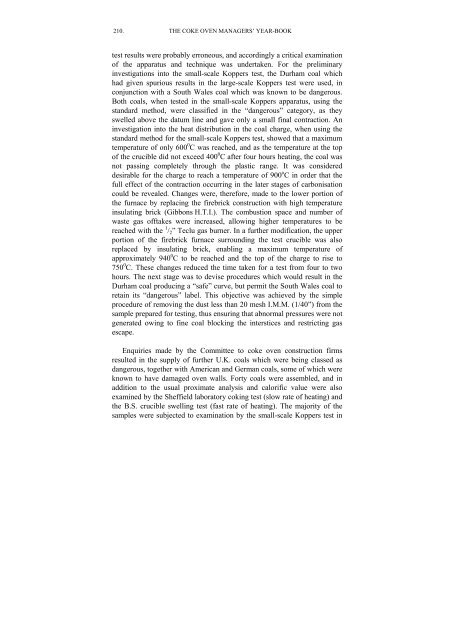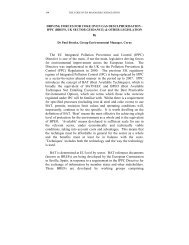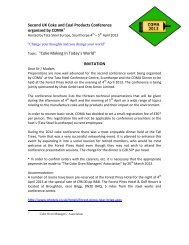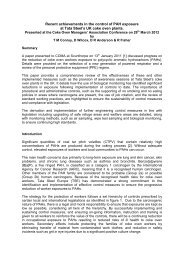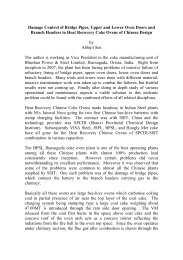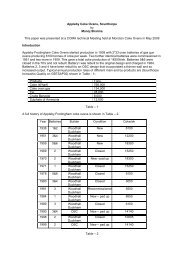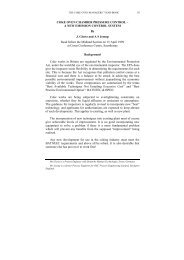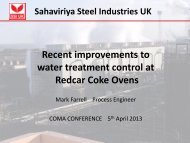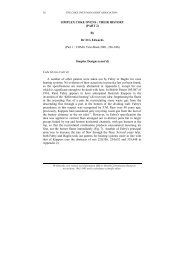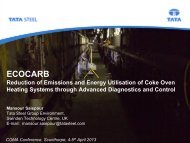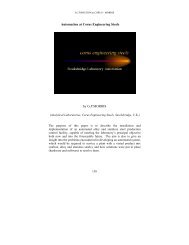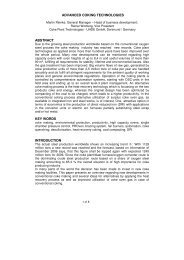CHAIRMAN'S ADDRESS - Coke Oven Managers Association
CHAIRMAN'S ADDRESS - Coke Oven Managers Association
CHAIRMAN'S ADDRESS - Coke Oven Managers Association
- No tags were found...
Create successful ePaper yourself
Turn your PDF publications into a flip-book with our unique Google optimized e-Paper software.
210. THE COKE OVEN MANAGERS’ YEAR-BOOKtest results were probably erroneous, and accordingly a critical examinationof the apparatus and technique was undertaken. For the preliminaryinvestigations into the small-scale Koppers test, the Durham coal whichhad given spurious results in the large-scale Koppers test were used, inconjunction with a South Wales coal which was known to be dangerous.Both coals, when tested in the small-scale Koppers apparatus, using thestandard method, were classified in the “dangerous” category, as theyswelled above the datum line and gave only a small final contraction. Aninvestigation into the heat distribution in the coal charge, when using thestandard method for the small-scale Koppers test, showed that a maximumtemperature of only 600 0 C was reached, and as the temperature at the topof the crucible did not exceed 400 0 C after four hours heating, the coal wasnot passing completely through the plastic range. It was considereddesirable for the charge to reach a temperature of 900 o C in order that thefull effect of the contraction occurring in the later stages of carbonisationcould be revealed. Changes were, therefore, made to the lower portion ofthe furnace by replacing the firebrick construction with high temperatureinsulating brick (Gibbons H.T.I.). The combustion space and number ofwaste gas offtakes were increased, allowing higher temperatures to bereached with the 1 / 2 ” Teclu gas burner. In a further modification, the upperportion of the firebrick furnace surrounding the test crucible was alsoreplaced by insulating brick, enabling a maximum temperature ofapproximately 940 0 C to be reached and the top of the charge to rise to750 0 C. These changes reduced the time taken for a test from four to twohours. The next stage was to devise procedures which would result in theDurham coal producing a “safe” curve, but permit the South Wales coal toretain its “dangerous” label. This objective was achieved by the simpleprocedure of removing the dust less than 20 mesh I.M.M. (1/40”) from thesample prepared for testing, thus ensuring that abnormal pressures were notgenerated owing to fine coal blocking the interstices and restricting gasescape.Enquiries made by the Committee to coke oven construction firmsresulted in the supply of further U.K. coals which were being classed asdangerous, together with American and German coals, some of which wereknown to have damaged oven walls. Forty coals were assembled, and inaddition to the usual proximate analysis and calorific value were alsoexamined by the Sheffield laboratory coking test (slow rate of heating) andthe B.S. crucible swelling test (fast rate of heating). The majority of thesamples were subjected to examination by the small-scale Koppers test in


